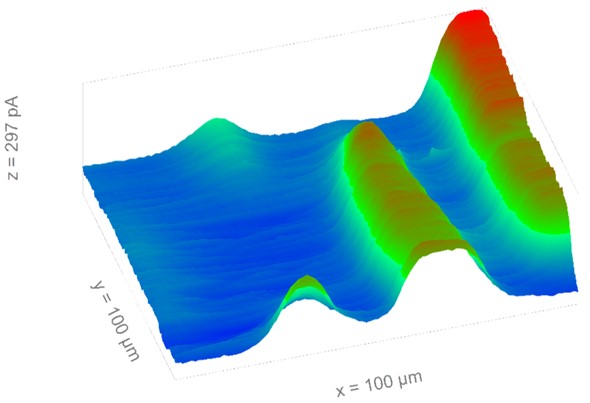ac/dc-SECM – M470.
The SECM470 module includes both Direct Current (dc)- and Alternating Current (ac)-SECM as standard
A versatile technique that can be used in a wide variety of applications including: materials research, catalysis, battery research and many others...
SECM470
Perform constant height Scanning ElectroChemical Microscopy measurements on BioLogic’s modular M470 with the SECM470 option.
The most versatile scanning probe electrochemistry technique
Scanning Electrochemical Microscopy (SECM) is a scanning probe electrochemistry technique capable of measuring the activity of a sample with chemical selectivity. The versatility of SECM makes it the most popular technique in this family. The SECM470 module includes both Direct Current (dc)- and Alternating Current (ac)-SECM as standard to allow researchers the highest level of flexibility in their experiments. The SECM470 performs SECM measurements in the constant height mode. For constant distance SECM measurements the ic-SECM470 module should be considered.
SECM is one of the most widely applicable scanning probe electrochemistry techniques. It is used in materials research, for example to investigate the latest 2D materials and alloyed metals. In the field of catalysis SECM has been applied to the high throughput screening of new catalyst chemistries. Similar investigations have been performed in the field of biosensors. In the field of biology SECM has been used to measure samples ranging from single cells to plants. The use of SECM in battery research is growing with a wide range of applications including investigating the solid electrolyte interface, measuring solid state electrolytes, and measuring the reactions occurring at battery electrodes. SECM can even be used in place of bulk electrochemistry measurements to measure accurate electrochemical kinetics.
SECM measurement of living spider plant leaf in 0.1 mM KCl. 1 µm Pt probe biased at -0.75 V.
Overview: Versatile high-resolution mapping of sample activity
- Wide variety of accessories
- High resolution
- Unlike other scanning probe microscopies the use of a redox mediator means there is chemical selectivity in the measurement.
Investigate local activity without a redox mediator using the ac-SECM technique
The SECM470 includes both dc-SECM and ac-SECM as standard. Unlike dc-SECM, ac-SECM allows researchers to investigate the local activity of a surface without the need for a redox mediator, or electrolytic salt. This makes it a very powerful technique because measurements can be performed in a system closer to the real world. ac-SECM has found use in corrosion because it does not require the use of species which may inhibit, or accelerate the corrosion of a surface. It is used in biology because a system which is non-toxic to living cells can be used. ac-SECM can be particularly useful for systems where a suitable redox mediator is not clear, such as organic electrolytes.
Measure conductors, semi-conductors, and even insulators
Most scanning electrochemical measurements, and indeed some scanning probe microscopies, require a sample that is conducting or semiconducting. Furthermore, the sample must be connected to the electronics of the system. This limits the potential candidates for measurement. SECM, however, can be used to measure conducting, semiconducting, and even insulating samples, which do not need to be connected to the electronics of the system. Because SECM does not require the sample to be active it can be used to measure a wide range of sample types from living cells to corroding metals, giving it a range not available for other scanning electrochemical measurements.
Sweep scan or step scan SECM measurements
Using the SECM470 dc-SECM can be performed in both step and sweep scan mode. With sweep scan mode the probe is continually moving during the measurement, which makes it faster than using the step scan mode. By using a sweep scan it is possible to use the SECM470 to measure dynamic, changing samples.
Tilt correction
Workstation Software
The Scanning Electrochemical Workstation software provides unique capabilities and interactivity in support of the Model 370 and Model 470 nanometer-resolution scanning probe microscopes. This highly ergonomic software has been designed to facilitate and improve the user experience and render work flows more efficient:
- Improved data analysis, manipulation and interactivity
- Automatic measurement and sequencing functionalities.
Over 40 discrete experiments provided throughout, each with their own individual variations
Specifications
| Scanning Stage | |
| Scan Range (x,y,z) | 110 mm x 110 mm x 110 mm |
| Minimal Step Size (x,y,z) | 20 nm |
| Positioning | Closed loop positioning, linear, zero hysteresis encoder with direct real-time readout of displacement in x, y, z |
| Linear position encoder resolution | 20 nm |
| Max Scan Speed | 10 mm/s |
| Measurement Resolution | 32-bit decoder @ up to 40 MHz |
| Dimensions | 500 mm (H) x 400 mm (W) x 675 mm (D) |
| Potentiostat | |
| SP-300 | |
| Compliance Voltage | ±12 V |
| Applied Potential | ±10 V |
| Resolution | 300 µV |
| Measured Potential | ±10 V |
| Resolution | 1.65 µV |
| Current Ranges | 100 pA to 1A |
| Maximum Current | ± 500 mA |
| Current Resolution | 76 aA |
| Floating Capability | Floating Mode |
| Cell Connections | 2, 3, or 4 electrode |
| Scan Rate | 1 µV/s to 200 V/s |
| Modes | Potentiostat, Galvanostat, OCP |
| EIS Capabilities | |
| Frequency Range | 10 µHz to 1 MHz |
| Analyzer Accuracy | 1%, 1° |
| Frequency Resolution | 0.1 nHz |
| General | |
| Available Probes | 1, 10, 15, and 25 µm Platinum |
| Available Experiments | Approach Curve Experiment, Line Scan Experiment, Area Scan Experiment, ac-SECM Approach Curve, ac-SECM Area Scan, SECM Modular Mapping Experiment (MME) Area Scan |






